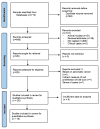Helicobacter Species and Hepato-Biliary Tract Malignancies: A Systematic Review and Meta-Analysis
- PMID: 36765552
- PMCID: PMC9913828
- DOI: 10.3390/cancers15030595
Helicobacter Species and Hepato-Biliary Tract Malignancies: A Systematic Review and Meta-Analysis
Abstract
Helicobacter species may cause chronic inflammation of the biliary tract, but its relationship with cancer is controversial. We performed a systematic review and meta-analysis to evaluate the association between Helicobacter species and hepatobiliary tract malignancies. Twenty-six studies (4083 patients) were included in qualitative synthesis, and 18 studies (n = 1895 qualified for meta-analysis. All studies were at high-intermediate risk of bias. Most studies combined several direct microbiological methods, mostly PCR (23 studies), culture (8 studies), and/or CLOtest (5 studies). Different specimens alone or in combination were investigated, most frequently bile (16 studies), serum (7 studies), liver/biliary tissue (8 studies), and gastric tissue (3 studies). Patients with Helicobacter species infection had an increased risk of hepatobiliary tract malignancies (OR = 3.61 [95% CI 2.18-6.00]; p < 0.0001), with high heterogeneity in the analysis (I2 = 61%; p = 0.0003). This effect was consistent when Helicobacter was assessed in bile (OR = 3.57 [95% CI 1.73-7.39]; p = 0.0006), gastric tissue (OR = 42.63 [95% CI 5.25-346.24]; p = 0.0004), liver/biliary tissue (OR = 4.92 [95% CI 1.90-12.76]; p = 0.001) and serum (OR = 1.38 [95% CI 1.00-1.90]; p = 0.05). Heterogeneity was reduced in these sub-analyses (I2 = 0-27%; p = ns), except for liver/biliary tissue (I2 = 57%; p = 0.02). In conclusion, based on low-certainty data, Helicobacter species chronic infection is associated with a tripled risk of hepatobiliary tract malignancy. Prospective studies are required to delineate public health interventions.
Keywords: Helicobacter; cancer; cholangiocarcinoma; neoplasms.
Conflict of interest statement
M.R.-P. received lecture fees from Astellas, Chiesi, and Advanz pharma, none of them related to the present work. The remaining authors have no conflict of interest to disclose.
Figures





Similar articles
-
Association between Helicobacter spp. infections and hepatobiliary malignancies: a review.World J Gastroenterol. 2015 Feb 7;21(5):1414-23. doi: 10.3748/wjg.v21.i5.1414. World J Gastroenterol. 2015. PMID: 25663761 Free PMC article. Review.
-
Helicobacter species infection may be associated with cholangiocarcinoma: a meta-analysis.Int J Clin Pract. 2014 Feb;68(2):262-70. doi: 10.1111/ijcp.12264. Epub 2013 Dec 22. Int J Clin Pract. 2014. PMID: 24373128 Review.
-
Infections of Helicobacter spp. in the biliary system are associated with biliary tract cancer: a meta-analysis.Eur J Gastroenterol Hepatol. 2013 Apr;25(4):447-54. doi: 10.1097/MEG.0b013e32835c0362. Eur J Gastroenterol Hepatol. 2013. PMID: 23470268
-
Comparative analysis of Helicobacter DNAs and biliary pathology in patients with and without hepatobiliary cancer.Carcinogenesis. 2002 Nov;23(11):1927-31. doi: 10.1093/carcin/23.11.1927. Carcinogenesis. 2002. PMID: 12419842
-
Helicobacter DNA in bile: correlation with hepato-biliary diseases.Aliment Pharmacol Ther. 2003 Feb;17(3):453-8. doi: 10.1046/j.1365-2036.2003.01424.x. Aliment Pharmacol Ther. 2003. PMID: 12562460
Cited by
-
Risk Factors and Prognostic Factors in GBC.J Clin Med. 2024 Jul 18;13(14):4201. doi: 10.3390/jcm13144201. J Clin Med. 2024. PMID: 39064241 Free PMC article. Review.
-
The causal relationship between gut microbiota and biliary tract cancer: comprehensive bidirectional Mendelian randomization analysis.Front Cell Infect Microbiol. 2024 Mar 15;14:1308742. doi: 10.3389/fcimb.2024.1308742. eCollection 2024. Front Cell Infect Microbiol. 2024. PMID: 38558852 Free PMC article.
-
Helicobacter pylori extract induces purified neutrophils to produce reactive oxygen species only in the presence of plasma.Biomed Rep. 2023 Oct 5;19(6):89. doi: 10.3892/br.2023.1671. eCollection 2023 Dec. Biomed Rep. 2023. PMID: 37901879 Free PMC article.
References
Publication types
LinkOut - more resources
Full Text Sources
Miscellaneous

